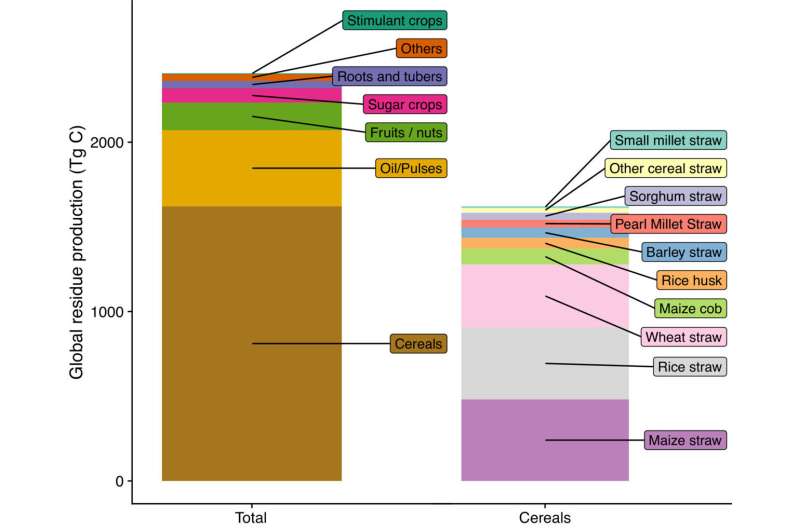This article has been reviewed according to Science X's editorial process and policies. Editors have highlighted the following attributes while ensuring the content's credibility:
fact-checked
peer-reviewed publication
trusted source
proofread
Maps reveal biochar's potential for mitigating climate change

Biochar, a charcoal made from heating discarded organic materials such as crop residues, offers a path to lowering atmospheric carbon dioxide (CO2) at a time when climate scientists warn that urgent action is needed limit CO2 in the atmosphere.
New maps, made from a first-of-its-kind high-resolution global dataset of crop residues, reveal areas where the residues may be sustainably used to produce biochar.
The research finds that 12 countries have the technical ability to sequester over 20% of their current total greenhouse gas emissions by converting crop residues to biochar. Bhutan leads the way with the potential to sequester 68% of its emissions in the form of biochar, followed by India, at 53%. The study, "Potential for Biochar Carbon Sequestration from Crop Residues: A Global Spatially Explicit Assessment," published in the journal GCB Bioenergy.
"We are entering an unprecedented era in which even a rapid and profound reduction in fossil fuel use will not be enough to avoid severe harms to both humans and ecosystems from climate change," said co-lead author Dominic Woolf, a senior research associate in the School of Integrative Plant Science Soil and Crop Sciences Section in the College of Agriculture and Life Sciences.
"We also need to draw down excess CO2," he said. "Making biochar from crop residues is one of the few tools we have that can do this at scale without competing for land."
Biochar improves soil fertility and benefits plant growth, while also offering a way to remove CO2 from the atmosphere. When added to soils, biochar sequesters carbon in the soil for centuries.
The study finds that, theoretically, if the total amount of crop residues generated by agriculture globally were converted into biochar, it would sequester a maximum of one billion metric tons of carbon stored annually. Three-quarters of that carbon would remain sequestered after 100 years, which represents enough to offset about 80% of all greenhouse gas emissions from agriculture.
"Even when considering limitations on sustainable residue harvesting and competing usage for crop residues—such as livestock feed—the global biochar production potential is approximately half of that amount," Woolf said.
When considering these limitations, potential global biochar production amounts to 510 million metric tons of carbon per year, with roughly 360 million metric tons remaining sequestered after 100 years.
"The high-resolution maps of crop residue production and biochar sequestration will provide valuable insights and support decision-making related to biochar production and investment in biochar production capacity," Woolf said.
More information: Shivesh Kishore Karan et al, Potential for biochar carbon sequestration from crop residues: A global spatially explicit assessment, GCB Bioenergy (2023). DOI: 10.1111/gcbb.13102
Journal information: GCB Bioenergy
Provided by Cornell University




















